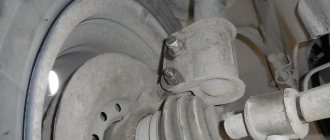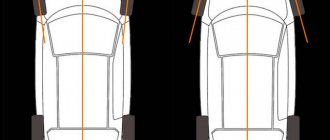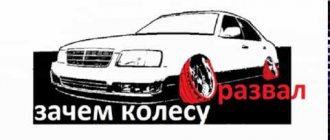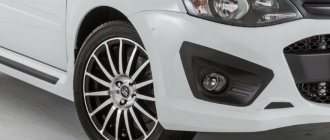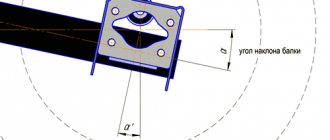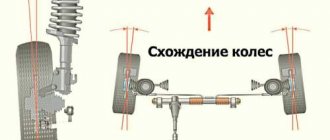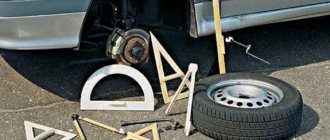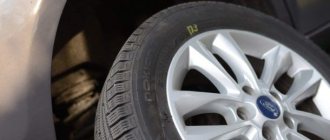How to adjust the wheel alignment of a Lada Granta car
To ensure good stability and controllability of the car, the front wheels are installed at certain angles relative to the body and suspension elements.
Three parameters are adjusted: the caster angle of the steering axis, the wheel camber angle and the wheel toe.
The caster angle is the angle between the vertical and the line passing through the centers of rotation of the ball joint and the upper bearing of the shock absorber strut in a plane parallel to the longitudinal axis of the vehicle.
The longitudinal inclination angle of the steering axis helps stabilize the steered wheels in the direction of straight-line motion.
Symptoms of deviation of the angle from the norm are the car pulling to the side when driving, different forces on the steering wheel in left and right turns, one-sided wear of the tire tread.
This angle is adjusted by changing the number of shims installed at both ends of the stretcher.
To increase the angle, washers are removed from the front or rear end of the stretcher, and to decrease the angle, they are additionally installed on the rear end of the stretcher (it is not always possible to install additional washers on the front end of the stretcher due to its short threaded part).
When installing or removing one shim, the caster angle of the steering axis changes by approximately 19′.
There should be no more than two adjusting washers at the front end of the stretch, and more than four at the rear end.
Wheel camber angle is the angle between the plane of rotation of the wheel and the vertical.
The camber angle of the wheel promotes the correct position of the rolling wheel during suspension operation.
If this angle deviates greatly from the norm, the vehicle may deviate from straight-line motion and cause one-sided wear of the tread.
The angle is adjusted by turning the upper bolt securing the shock absorber strut to the steering knuckle while loosening the nuts of the upper and lower bolts.
Wheel toe is the angle between the plane of rotation of the wheel and the longitudinal axis of the car.
Sometimes this angle is calculated by the difference in the distances between the edges of the rims, measured from the back and front of the wheels at the level of their centers.
Wheel toe ensures the correct position of the steered wheels at various vehicle speeds and turning angles.
Toe is adjusted by rotating the adjusting threaded bushings with the tie rod ends loosened.
Before adjustment, the steering rack is set to the middle position (steering wheel spokes are horizontal).
Signs of toe deviation from the norm: severe saw-tooth wear of tires in the transverse direction (even with small deviations), squealing of tires when cornering, increased fuel consumption due to high rolling resistance of the front wheels (the vehicle's run-out is much less than required).
It is recommended to check and adjust the angles of the front wheels at a service station.
Before doing this, you should make sure that:
— tire pressure is normal;
— tread wear on the left and right wheels is approximately the same;
— there is no play in the front wheel hub bearings;
— there are no backlashes in the steering drive;
— suspension elements are free from deformation and damage;
— rubber-metal suspension joints have no wear damage;
- the wheel rims are not deformed (radial runout - no more than 0.7 mm, axial runout - no more than 1 mm).
Checking the wheel alignment angles is mandatory if suspension parts that affect these angles have been replaced or repaired.
Due to the fact that the installation angles of the front wheels are interconnected, first of all the angle of the longitudinal inclination of the turning axis is checked and adjusted, then the camber and, lastly, the toe-in.
After installing the car on the stand to control the angles, it is necessary to “squeeze” the car’s suspension by applying force two or three times in the vertical plane to the rear and then to the front bumpers.
Front wheel alignment angles under a load of 320 kg
Front wheel camber, hail
Front wheel toe-in, mm
Longitudinal inclination of the wheel turning axis, degrees
Installation angles of the front wheels of the equipped vehicle
Front wheel camber, hail
Front wheel toe-in, mm
Longitudinal inclination of the wheel turning axis, degrees
Description
Many modern cars have negative camber on the rear axle, which is built into the design initially, and this angle reaches 2 or even more degrees. Owners of VAZ cars (except for the latest Grant and Kalina-2 models) have zero wheel camber on the rear axle of their cars. It is possible to establish negative camber of the rear wheels using camber plates, which are installed between the rear beam and the rear wheel hub axle.
As you know, when installing many camber plates widely available on the market, in addition to obtaining a camber of -1°, we also get negative toe-in of the rear wheels, which has a bad effect on handling. This result is obtained due to the fact that when designing these spacers, manufacturers do not take into account the angle of inclination of the rear beam arm. Negative toe-in of the rear wheels increases the likelihood of skidding when cornering, as the car receives excessive oversteer, and when driving in a straight line under the influence of road unevenness and lateral influences (for example, wind or when driving on a rut), the car requires constant steering and becomes excessively sharp and unstable .
When designing the SS20 spacers, the angle of inclination of the rear beam arm was taken into account. The axis of symmetry of the camber plate was shifted by an angle α equal to the inclination of the beam lever. This solution allows you to maintain stable behavior of the car when turning and driving in a straight line. When installing SS20 camber plates, a -1° camber and a slight positive toe-in of the rear axle wheels are provided.
The use of branded SS20 spacers, which give negative camber to the rear wheels, slightly increases their track. This has a positive effect on maneuverability. A wider track allows you to increase cornering speed without the risk of tipping over.
In addition, increasing the camber to -1° improves high-speed cornering, since wheels with negative camber perceive a greater amount of lateral forces without “breaking” the tires, which reduces deviation from the trajectory.
When the body rolls in corners, the most loaded wheels with negative camber retain a larger contact patch and better grip. Toe compensation allows the wheel to roll with the least resistance and reduces tire wear.
For each specific model, the dimensions are calculated separately depending on its weight, dimensions, technical characteristics of the engine, suspension, braking system, expected operating modes of the vehicle and much more.
The software of special computer equipment for wheel alignment adjustment contains the factory parameters of certain models, and the technician just has to select the desired settings.
Lada Granta / Zeta-Jones › Logbook › About wheel alignment
After the spring suspension repair (part 1, part 2), the issue of correct wheel alignment on the car was involuntarily raised. Correctly set camber, toe and caster angles, as well as incorrect ones, can significantly change the car’s behavior on the road, this should be especially noticeable at high speeds.
**************************************** **************************************** ******************* 1. To begin with, I turned to Tyrnet for optimal wheel alignment angles, and it turned out that the factory recommends the following values:
Curb vehicle, front axle:
Camber 0 degrees +/- 30 minutes Caster 1 degree 15 minutes +/- 30 minutes (without power steering) 2 degrees 20 minutes +/- 30 minutes (with power steering) Linear toe 2 +/- 1 mm angular 0 degrees 10 minutes - 0 degrees 30 minutes
Rear axle:
Camber -1 degree Toe-in total 10 minutes
**************************************** **************************************** ******************* 2. Next, I pulled up a printout of the very first measurements from TO-1 to 2300 km
in DAV-Auto (back in autumn 2012). To my surprise, the work was carried out using the map of the first Kalina (thanks for not using 2110). By that time, the car had been on sale for a whole year, and it was strange that OD did not have the correct parameters in its equipment.
Before:
Caster - good Camber - ok Toe - good
Rear:
Camber - ok
Toe - incomprehensible, terribly high
(apparently a side effect of using a map of a different car model)
**************************************** **************************************** ******************* 3. Last fall, the springs around were replaced with TechnoRessor -30, after which I went to adjust the wheel alignment on a 3D stand in the Kar-Ib garage. By the way, before the measurements they didn’t even check or ask about the tire pressure. In addition, after the adjustments, the steering wheel began to point to the left, but I did not return to them for alterations. The results were as follows:
Two questions arise here: why such a huge caster? - Why is the camber on the rear wheels so different?
The only reason for the increase in caster could only be the lowering; no other changes were made to the suspension. But this option was in doubt. Firstly, such a caster would be visually noticeable; the wheels should already be close to the front bumper. Secondly, it’s simply logically difficult to explain how understatement can have such an effect on caster.
But regarding the camber at the rear, there were several options: a bent beam, inaccurate measurements, a crooked wheel.
**************************************** **************************************** ******************* 4. Before the upcoming spring repair of the suspension, I decided to check the stand again and take measurements. But for a reason. The reason was the following - visually it seemed that the right wheel had a negative camber, despite the fact that the right one was level. I thought that the car had gone through a hole somewhere badly. To exclude my cretinism, I showed the wheel to the guys I knew, and they nodded in agreement, saying that the left wheel was indeed “down.” But the 3D stand of the same Kar-Iba showed the following...
So we see: — the camber on both wheels is positive! (You need to show your eyes to the ophthalmologist) - castor again, I don’t know what kind. The wrecker stated that it had never matched on more than one of their cars! What? Don't go there anymore. In addition, the tire pressure was not checked again before the measurements. — Again, everything is bad with the rear beam, apparently bent, sadness.
Conservatism or modern approach, which is better?
But such a conservative approach is more suitable for old Ladas, Muscovites, Volgas, Cossacks, as well as ancient foreign cars.
On modern cars, it is, of course, better to carry out such work at a service station, where, with the help of modern laser and computer equipment, everything will be done at a high level without any errors. And we all know that even a small error in this matter can lead to rapid tire wear.
A service station is certainly good, they will do everything quickly and accurately. But there is always a BUT. Firstly , no matter what modern equipment is in a car service center, without a good specialist it is a pile of scrap metal. And here problems can arise:
1. How much do you trust this specialist;
2. How accurately will the work be carried out (when the equipment was checked for compliance with metrological standards) and whether such accuracy is worth the money;
Lada Granta
I’m probably the first journalist who managed to not only test the Granta, but also compare its behavior on the road with the Kalina, a direct relative and predecessor. The AVTOVAZ testing ground is excellent for these purposes: the access roads are very similar to most Russian highways. There are flat areas with fast turns, small grooves, cracks, joints, and waves.
First I jump into Kalina. It shakes harshly on uneven surfaces and oversteer occurs in corners, which has to be corrected with an uninformative, light steering wheel. Feelings familiar from my editorial station wagon. Now I’m transferring to Granta...
They put a lot of work into the chassis, I can feel it right away. There was effort on the steering wheel - it became easier to feel the trajectory. Of course, a little more transparency wouldn't hurt. But this is if we compare Grant with foreign analogues, primarily with Renault Logan. And from the starting point - Kalina - Granta took a good step forward. Although the testers from the development bureau were faced with a difficult task: to take the existing (far from ideal) chassis as a basis and squeeze the maximum possible out of it at a minimum cost.
Sergey MEDINETS, chief designer of the Lada-Granta project
In the middle of last year, the first prototypes of the future Granta appeared, on which the nuances associated with the original body were checked, and the first comprehensive tests of the car as a whole were carried out. In the second quarter of this year, a pilot batch was produced, and at the end of summer - an installation batch made using serial production technologies. Now it remains to eliminate minor defects. Now “Granta” is undergoing certification tests at the NITSIAMT test site, which we plan to complete by mid-autumn.
“GRANT” IS NOT WORKING ON THE MISTAKES MADE DURING THE DEVELOPMENT OF “KALINA”. THIS CAR IS CLOSER TO ALL OTHER VAZ MODELS TO FOREIGN ANALOGUES IN LEVEL AND DESIGN Elaboration.
Lada Granta Ivanych › Logbook › Wheel alignment Caster
After the winter period, I changed the tires to summer ones and felt that the car was pulling to the left. I checked the ball joints and ends, visually inspected the front and rear suspensions, and saw no flaws. I checked the car's alignment and alignment. But it was not immediately possible to find reference information for Granta. I read on one of the forums that the reason a car pulls to the side can be the wheels themselves, or rather the tires on them. Sometimes it is enough to change the front right and left seats and the drift will stop. I didn’t attach much importance to it at the time, but that was in vain. In short, I drove like this for about a month, after changing the tires to new ones I was almost stunned, everything returned as it should be. Again to the forum, where they write that summer tires are changed like this: where you removed the wheel from, put it back there and don’t confuse places. I removed the right front one, returned it there in the spring, etc. all wheels. True, this advice applies to those who have not changed their camber or caster over the winter. I removed and installed wheels without any consideration of places.
Background information: This is a temporary recording, so please copy it for reference.
● Granta, under load: camber 0 degrees +/- 30 minutes caster 1 degree 40 minutes +/- 30 minutes (without ESD) 3 degrees +/- 30 minutes (with ESD) linear toe 0 +/- 1 mm angular 0 degrees +/- 10 minutes
● Granta, equipped car: camber 0 degrees +/- 30 minutes caster 1 degree 15 minutes +/- 30 minutes (without ESD) 2 degrees 20 minutes +/- 30 minutes (with ESD) linear toe 2 +/- 1 mm angular 0 degrees 10 minutes - 0 degrees 30 minutes.
● For Lada Granta, which are equipped with power steering (standard and luxury configurations), the front suspension caster is increased. It will be 2°45'.
I’ll insert the information somewhere in my blog. PS I'm saving. And I’m adding to the post.
Caster angle is the angle between the steering axis of the wheel and the vertical in a side view. It is considered positive if the axis is tilted backward relative to the direction of movement.
Camber
- the inclination of the wheel plane to the perpendicular restored to the plane of the road. If the top of the wheel is tilted outward of the car, then the camber angle is positive, and if it is tilted inward, it is negative.
Convergence
- the angle between the longitudinal axis of the vehicle and the plane passing through the center of the steering wheel tire. Toe is considered positive if the planes of rotation of the wheels intersect in front of the car, and negative if, on the contrary, they intersect somewhere behind.
Below are experiments to understand how wheel adjustments affect the behavior of the car. The Samara VAZ-2114 was chosen for testing - most modern foreign cars do not burden the owner with a range and choice of adjustments. All the parameters there are set by the manufacturer and it is quite difficult to influence them without structural modifications. The new car has an unexpectedly light steering and slurred behavior on the road. The wheel alignment angles are within the tolerance range, with the exception of the longitudinal angle of inclination of the left wheel (caster) axis of rotation. In relation to the front suspension of a domestic front-wheel drive car, setting the angles always begins with adjusting the caster. It is this parameter, on the one hand, that is decisive for the rest, and on the other hand, it has a lesser effect on tire wear and other nuances associated with the rolling of the car. Moreover, this operation is the most labor-intensive - I think that is why they “forget” about it at the factory. Only then, having dealt with the longitudinal angles, does a competent master begin to adjust the camber, and then the toe-in. • Option 1
The master shifts the angles of the longitudinal inclination of the racks as much as possible, taking them to the “minus”.
We seem to be moving the front wheels back towards the mudguards of the wheel arches. A situation that quite often occurs on old and heavily used cars or after installing spacers that raise the rear of the car. The result: light steering, quick responses to its slightest deviations. However, “Samara” has become overly nervous and fidgety, which is especially noticeable at speeds after 80-90 km/h and above. The car has unstable responses when entering a turn (not necessarily fast), tends to venture to the side, requiring the driver to constantly steer. The situation becomes more complicated when performing the “rearrangement” maneuver. Option 2
“Correct” position of the struts (tilted to “plus”), toe and camber angles are set to “zero”.
The steering wheel has become elastic and informative, and a little “heavier”. The car drives clearly, clearly and correctly. The agility, unclear relationships and trajectory yaw have disappeared. At the “rearrangement”, the VAZ easily outperformed the previous version. Option 3
Excessively “positive” camber.
It is undesirable to change it without toe correction, therefore positive toe is also introduced. The steering wheel became lighter again, the responses at the entrance to turns became lazier, and the lateral movement of the body increased. But there is no catastrophic deterioration in character. However, when simulating an extreme situation, the “steering feel” is lost. With the advent of slips, unexpectedly early it becomes difficult to get into the given corridor at the “rearrangement” and the car begins to slide too early. In fast corners, the strongest slip of the front axle dominates. Option 4
Option with sporting ambitions: everything is “minus”, with the exception of the caster. A car with such settings turns more confidently and faster, as does the “rearrangement” maneuver. Hence the best result.
So, there are a lot of simple and very effective ways to change the character of a car without resorting to expensive replacements of components and parts. The main thing is not to neglect the adjustments - they often turn out to be very important. Which option should you prefer? For most, the second will be acceptable. It is the most logical for everyday driving, both with partial and full load. You just need to take into account that by increasing the longitudinal tilt of the rack, you not only improve the behavior of the car, but also increase the stabilizing (return) force on the steering wheel. The last, “fastest” tuning option is more suitable for the near-sporting public who likes to improvise with the car. When giving preference to these adjustments, it must be taken into account that with increasing load, the values of the toe and camber angles will increase and may go beyond the permissible limits.
Messages 12
1 Topic by Gray 2015-12-17 17:48:26
- Gray
- Participant
- Inactive
- Messages: 10
- Thank you: 1
Topic: Camber/alignment on the new Vesta
It seemed that the car was being pulled a little to the side. They told me to travel a little more and then if they check anything, when will there be a special program for Vesta. Or am I being stupid, since it’s the first time using an electric steering wheel, it’s a little unusual, but there is still a difference with a hydraulic steering wheel.
New cars from the factory should have an adjusted camber, or who is lucky?
There is still the intrigue of waiting for various “gadgets” and “body kits” in the GT style, as well as new color schemes and an original interior. All this takes place in the presented new product, sales of which started in the fall of 2022.
How to adjust wheel alignment for a non-professional: a simple old-fashioned method
The wheel alignment characteristics ensure a tight contact patch between the road surface and the tire, and the vehicle's stability when turning. The intensity of tire wear depends on them. Incorrect adjustment of these parameters will increase fuel consumption.
When driving, the driver needs to constantly make efforts to hold the steering wheel. As the speed increases, the decrease in stability becomes dangerous. Adjusting wheel alignment yourself is not an impossible task. By following simple instructions, even an ordinary car enthusiast can do this.
Numbers you need to know
To set the wheels at the correct angles, you need to know these angles, everything is logical.
Definitions for front wheels
What is CASTER
The standard value is 6 degrees.
Thanks to this angle, wheel alignment is ensured due to speed. The CAMBER angle (aka CAMBER) determines the correct lateral inclination of the wheel.
Thanks to the correctly set CAMBER angle, the wheels are aligned due to the weight of the vehicle.
How to understand that adjustment is needed and why it is important
This procedure should be performed twice a year when replacing tires seasonally. Modern cars are most often serviced in specialized car repair shops. Specialized stands and computers are used here. This procedure can be carried out on your own.
First, it is important to learn to recognize the need for such adjustments. In this case, you should focus on the following signs:
- uneven tire wear;
- constant pulling of the car to the side during straight-line movement;
- difficulty driving a car;
- uneven wear of the edges of the front wheel groove.
If at least one of the listed signs is present, then you need to immediately take adequate measures to solve the problem.
Instructions
Before you start adjusting the wheel alignment, you should definitely check the chassis of the car. If necessary, you need to repair it by replacing worn components and suspension parts. In addition, before work you need to equalize the tire pressure and unload the trunk.
Tools and materials
To perform wheel alignment adjustments with your own hands, you will need the following items and tools, which will not be difficult to find:
- ruler;
- chalk;
- standard set of wrenches;
- cord with a plumb line.
Work should be carried out on a level area with an inspection hole or a lift.
Our actions
Today, most often on the roads there are cars with rack and pinion steering and MacPherson-type front suspension.
To adjust the toe-in, you need to perform the following sequential steps:
- Place the car on a pit or lift, ensuring unobstructed access to the steering rods.
- Unlock the steering column lock, then turn each wheel from one extreme position to the other. After this, install them in the central position.
- Using a ruler, find the point that is in the middle of the distance between the two ball joints.
- Measure the wheel rims on the inside. First determine the distance from one leading edge to the other, and then from one trailing edge to the other. The difference between these values is precisely the camber angle. Compare the obtained data with technical standards for a specific car.
- To adjust, you need to loosen the steering rod lock nut and turn the couplings until the angle of one wheel coincides with the other.
To confirm the match, you need to measure the distance from the midpoint to each wheel. These values should be equal. After this, tighten the locknuts.
To adjust wheel alignment, rotating eccentrics and shim plates are often used.
Adjusting the wheels yourself will save you a lot of money. On the other hand, work done incorrectly can lead to negative results. Therefore, for modern cars, a professional car service is better suited.
Possible nuances
All of the above can also be applied to cars with other types of suspension. However, depending on the design features of a number of elements, there may be significant differences. For example:
- Cars where a gearbox and steering linkage are installed instead of a rack and pinion drive require special attention to the condition of the bushings and the pendulum hinge. Their wear affects the adjustment, and it can often be detected only with a certain position of the parts.
- On machines with a pivot suspension, when adjusting the camber produced by rotating the eccentric, the caster also changes. It will also have to be controlled.
- Some car models provide toe adjustment not only for the front, but also for the rear wheels. In most cases, this parameter changes when the coupling mounted on the transverse link connecting the rear wheels is rotated.
- If the car has all-wheel drive and a continuous front axle is installed, then the design does not provide for camber adjustment.
You can do the job efficiently only if you know all these features.
The master's work is afraid
Of course, your task will be greatly simplified if you decide to invest in professional equipment. It is not necessary to purchase a complex stand with laser sensors and a computer terminal that processes information, connected to a database that contains all the necessary parameters for hundreds of machine models.
A relatively inexpensive optical stand is quite sufficient. The domestic version of such a device, SKO-1M, can be found in stores for a very reasonable price, around 60,000 rubles. , price. For a used one they ask for even less.
It’s not easy to do a wheel alignment yourself. What looks easy in words, in practice requires serious expenditure of physical and nervous strength. You shouldn’t expect that everything will work out the first time. You'll have to be patient. Remember that the most advanced wheel alignment equipment will not make you an experienced specialist. But in the hands of a master, even an ordinary PSK-LG line can work wonders!
>
